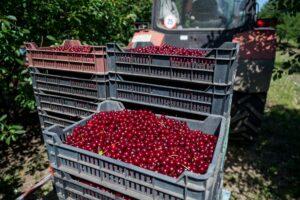This year’s sour cherry harvest is much weaker than usual
This year, the weather was not favorable for the sour cherry harvest either, spring frost damage was significant in the plantations, and producers were only able to harvest significant quantities of mid- or late-ripening varieties. According to the overview of the National Chamber of Agriculture (NAK) and the Hungarian Vegetable and Fruit Interprofessional Organization (FruitVeB), despite the low harvest, there was significant demand for Hungarian sour cherries on the international market, which also pushed prices up extremely.
 The spring frost caused significant damage to the domestic sour cherry harvest, this year’s harvested quantity is far below the 60-70 thousand tons that can be produced in good years, but the harvest was much weaker than last year’s harvest, which was also very low. Although the exact volume of the harvested sour cherry crop is not yet known, the Hungarian Fruit and Vegetable Association (FruitVeB) estimates that the harvest will be closer to 30,000 tonnes than to 40,000 tonnes.
The spring frost caused significant damage to the domestic sour cherry harvest, this year’s harvested quantity is far below the 60-70 thousand tons that can be produced in good years, but the harvest was much weaker than last year’s harvest, which was also very low. Although the exact volume of the harvested sour cherry crop is not yet known, the Hungarian Fruit and Vegetable Association (FruitVeB) estimates that the harvest will be closer to 30,000 tonnes than to 40,000 tonnes.
The largest losses were recorded in early varieties, with significant volumes coming from ‘cluster sour cherries’, which shortened the domestic processing season. However, spring frosts not only decimated the domestic sour cherry crop, but also caused drastic crop losses in major European sour cherry producing countries. This led to a strong over-demand for the fruit on both the domestic and international sour cherry markets. Demand was further increased by the fact that stocks of processed sour cherry products (cherry preserves, frozen sour cherries, sour cherry concentrate) were low both at home and abroad, partly due to the poor Hungarian and Polish harvests last year. Since the sour cherry harvest was also weak in other European countries, in addition to Poland and Germany, which are our main export markets, there has been a greater interest in Hungarian sour cherries from other markets. In the case of preserved sour cherries, Hungary is the dominant European producer, while in the case of frozen sour cherries and sour cherry concentrate, Poland, Serbia and Turkey are the dominant producers. A significant part of domestic sour cherries is exported: 25% of exports are fresh (raw) sour cherries as raw material, 70% are preserved, and 5% are frozen.
Related news
Chamber of Agriculture: 10 percent more new wine was produced this year than last year
🎧 Hallgasd a cikket: Lejátszás Szünet Folytatás Leállítás Nyelv: Auto…
Read more >AM: Government helps farmers with a loan moratorium
🎧 Hallgasd a cikket: Lejátszás Szünet Folytatás Leállítás Nyelv: Auto…
Read more >There will be no shortage of high-quality Hungarian fish, according to professional organizations
🎧 Hallgasd a cikket: Lejátszás Szünet Folytatás Leállítás Nyelv: Auto…
Read more >Related news
Akcenta: The Hungarian economy returned to growth in 2025, risk management will come to the fore in 2026
🎧 Hallgasd a cikket: Lejátszás Szünet Folytatás Leállítás Nyelv: Auto…
Read more >At profit temperature – 3 climate trends reshaping the economy
🎧 Hallgasd a cikket: Lejátszás Szünet Folytatás Leállítás Nyelv: Auto…
Read more >BMI: The manufacturing industry ended the year with sustained expansion
🎧 Hallgasd a cikket: Lejátszás Szünet Folytatás Leállítás Nyelv: Auto…
Read more >







